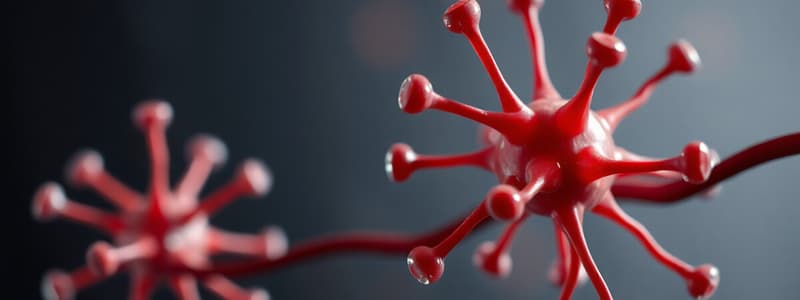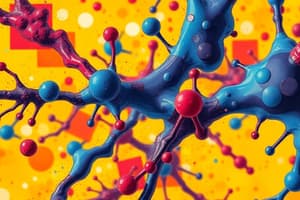Podcast
Questions and Answers
Which structural modification to norepinephrine would likely decrease its potency at adrenergic receptors?
Which structural modification to norepinephrine would likely decrease its potency at adrenergic receptors?
- Addition of a methyl group on the amino end.
- Absence of one or both -OH groups on the benzene ring. (correct)
- Addition of a group on the α-carbon.
- Presence of -OH groups on the benzene ring.
Why does the addition of a group on the α-carbon of norepinephrine affect its function?
Why does the addition of a group on the α-carbon of norepinephrine affect its function?
- It renders it resistant to MAO. (correct)
- It increases its susceptibility to COMT.
- It enhances its binding affinity to α-receptors.
- It decreases its binding affinity to β-receptors.
How does increasing the size of the group on the amino end of norepinephrine impact its receptor activity?
How does increasing the size of the group on the amino end of norepinephrine impact its receptor activity?
- Increases both α- and β-receptor activity.
- Increases α-receptor activity and decreases β-receptor activity.
- Decreases α-receptor activity and increases β-receptor activity. (correct)
- Decreases both α- and β-receptor activity.
Which of the following is true regarding norepinephrine's receptor affinity?
Which of the following is true regarding norepinephrine's receptor affinity?
Why does epinephrine bind to all adrenergic receptors with relatively equal affinity?
Why does epinephrine bind to all adrenergic receptors with relatively equal affinity?
A drug is found to selectively activate α1-adrenergic receptors. Which of the following drugs is most similar in its action?
A drug is found to selectively activate α1-adrenergic receptors. Which of the following drugs is most similar in its action?
Which of the following effects would be expected from a drug that selectively blocks β2-adrenergic receptors in the eye?
Which of the following effects would be expected from a drug that selectively blocks β2-adrenergic receptors in the eye?
What is the likely physiological response in the heart following the administration of a β1-adrenergic antagonist?
What is the likely physiological response in the heart following the administration of a β1-adrenergic antagonist?
What effect would an α1-adrenergic antagonist have on blood vessels?
What effect would an α1-adrenergic antagonist have on blood vessels?
Administration of a beta-blocker leads to decreased blood pressure. What compensatory mechanism is triggered by the baroreceptor reflex?
Administration of a beta-blocker leads to decreased blood pressure. What compensatory mechanism is triggered by the baroreceptor reflex?
Following the administration of an alpha-blocker, the baroreceptor reflex is activated. What effect will this have on the heart?
Following the administration of an alpha-blocker, the baroreceptor reflex is activated. What effect will this have on the heart?
In the bronchi, what effect does blocking β2 receptors have?
In the bronchi, what effect does blocking β2 receptors have?
A drug that blocks β2 receptors in the GI tract would likely cause which of the following effects?
A drug that blocks β2 receptors in the GI tract would likely cause which of the following effects?
How does blocking α2 receptors in the GI tract affect gastrointestinal function?
How does blocking α2 receptors in the GI tract affect gastrointestinal function?
What effect does blocking α1 receptors have on the sphincters of the GI tract?
What effect does blocking α1 receptors have on the sphincters of the GI tract?
What is the expected effect of blocking β2 receptors in the urinary bladder?
What is the expected effect of blocking β2 receptors in the urinary bladder?
How would an α1-adrenergic antagonist affect the urinary bladder sphincter?
How would an α1-adrenergic antagonist affect the urinary bladder sphincter?
Which of the following represents the mechanism of action of a mixed-acting sympathomimetic drug?
Which of the following represents the mechanism of action of a mixed-acting sympathomimetic drug?
If a drug is designed to be resistant to MAO, what structural modification would likely be present?
If a drug is designed to be resistant to MAO, what structural modification would likely be present?
In most organs, the sympathetic nervous system (SNS) and parasympathetic nervous system (PSNS) act as physiological antagonists. Therefore, what effect would adrenergic antagonists generally have?
In most organs, the sympathetic nervous system (SNS) and parasympathetic nervous system (PSNS) act as physiological antagonists. Therefore, what effect would adrenergic antagonists generally have?
Flashcards
Sympathomimetic Drugs
Sympathomimetic Drugs
Drugs that mimic the effects of sympathetic nervous system stimulation.
Norepinephrine's -OH Groups
Norepinephrine's -OH Groups
Presence of -OH groups makes it a catecholamine; absence decreases potency and increases susceptibility to COMT.
α-Carbon Group Addition
α-Carbon Group Addition
Addition makes the compound resistant to degradation by MAO.
Amino End Group Effects
Amino End Group Effects
Signup and view all the flashcards
Norepinephrine receptor binding
Norepinephrine receptor binding
Signup and view all the flashcards
Epinephrine receptor binding
Epinephrine receptor binding
Signup and view all the flashcards
Phenylephrine receptor binding
Phenylephrine receptor binding
Signup and view all the flashcards
Clonidine receptor binding
Clonidine receptor binding
Signup and view all the flashcards
Yohimbine receptor binding
Yohimbine receptor binding
Signup and view all the flashcards
Propranolol receptor binding
Propranolol receptor binding
Signup and view all the flashcards
Butoxamine receptor binding
Butoxamine receptor binding
Signup and view all the flashcards
SNS & PSNS antagonism
SNS & PSNS antagonism
Signup and view all the flashcards
Alpha-1 Blockers on Eye
Alpha-1 Blockers on Eye
Signup and view all the flashcards
Beta Blockers on Eye
Beta Blockers on Eye
Signup and view all the flashcards
Beta-1 Blockers on Heart
Beta-1 Blockers on Heart
Signup and view all the flashcards
Alpha-1 Blockers on Blood Vessels
Alpha-1 Blockers on Blood Vessels
Signup and view all the flashcards
Beta-2 Blockers on Blood Vessels
Beta-2 Blockers on Blood Vessels
Signup and view all the flashcards
Beta-1 Blockers Effect
Beta-1 Blockers Effect
Signup and view all the flashcards
Alpha-1 Blockers Effect
Alpha-1 Blockers Effect
Signup and view all the flashcards
Beta-2 Blockers on Bronchi
Beta-2 Blockers on Bronchi
Signup and view all the flashcards
Study Notes
- Sympathomimetic drugs are a class of medications that stimulate the sympathetic nervous system.
- The presence of -OH groups in Norepinephrine classifies it as a catecholamine.
- The absence of one or both -OH groups reduces potency at adrenergic receptors and increases susceptibility to COMT.
- Adding a group on the α-carbon makes the compound resistant to MAO.
- Adding a group on the amino end changes receptor affinity.
- Larger groups decrease α-receptor activity and increase β-receptor activity.
Receptor Agonists
- Direct-acting agonists directly bind to and activate adrenergic receptors.
- Mixed-acting drugs have both direct and indirect actions on adrenergic receptors.
- Norepinephrine has affinity α1=α2, β1>>β2, needing very high concentrations to activate β2.
- Epinephrine has affinity α1=α2, β1=β2, and can bind to all receptors due to methyl groups.
ALPHA Agonists
- Phenylephrine’s affinity is α1>>α2.
- Clonidine’s affinity is α1>α2.
- Yohimbine’s affinity is α1>α2.
BETA Agonists
- Propranolol’s affinity is β1=β2.
- Butoxamine’s affinity is β2>>>β1.
Adrenergic Antagonists
- In most organs, the SNS and PSNS are physiological antagonists, so adrenergic antagonists have similar effects to PSNS activation.
Effects of Adrenergic Antagonists on the Body
- Eye: Blocking α1 causes pupil constriction; blocking β2 and β1 decreases aqueous humor production.
- Heart: Blocking β1 decreases heart rate and force of contraction.
- Blood Vessels: Blocking α1 causes vasodilation; blocking β2 causes vasoconstriction.
Baroreceptor Reflex Response
- Beta-blockers inhibit β1, which decreases heart rate and force of contraction.
- Baroreceptors detect decreased BP, which decreases PSNS and increases SNS vasoconstriction via α1.
- Alpha-blockers inhibit α1 in blood vessels, causing vasodilation.
- Baroreceptors detect decreased BP, which decreases PSNS and increases SNS, leading to increased heart rate via β1.
Effects on Smooth Muscle
- β2 receptors are typically found on the smooth muscle wall of an organ.
- α1 receptors are typically found on sphincter smooth muscle.
- Bronchi: Blocking β2 causes bronchoconstriction.
- GI Tract: Blocking β2 increases motility; blocking α2 increases ACh release and motility; blocking α1 relaxes the sphincter.
- Urinary Bladder: Blocking β2 contracts the bladder; blocking α1 relaxes the sphincter.
Studying That Suits You
Use AI to generate personalized quizzes and flashcards to suit your learning preferences.




